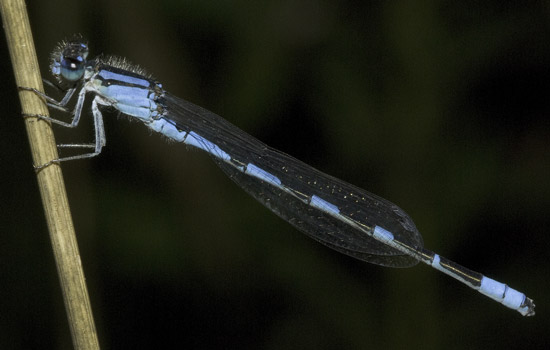Capturing and Photographing Dragonflies is a Passion of RIT Alumni
Husband and wife team identify species new to Monroe County
Steve Diehl and Vici Zaremba-Diehl
Tule Bluet, Enallagma carunculatum, 2008 RIT campus
Rochester Institute of Technology photography professor Steve Diehl and his wife, Vici, both RIT alumni, are working with the New York Natural Heritage Program to help identify and document 190-plus species of Odonata (dragonflies and damselflies) in New York state—including three on RIT’s campus and one in the town of Parma that are new to Monroe County. The Diehls are part of a group of professionals and volunteers working across the state
One of the goals of the project is to create, in collaboration with the New York Department of Environmental Conservation and the Natural Heritage Program, a New York state field guide.
Damselflies and dragonflies are suborders of the order Odonata that range in size from one to four inches in length. Damselflies are generally smaller and more delicate than dragonflies and can be distinguished by their resting wings, which are held together or partially open over their abdomens. Dragonflies’ wings, at rest, are always straight out at their sides like an airplane.
“While most people like dragonflies and damselflies, it is only recently that thorough surveying and research efforts have begun,” Vici Diehl says. “Many birders and other naturalists have turned their attention to damsels and dragons as so little is known about them.”
The Diehls joined the research effort as volunteers in 2007 to help gather data. They have put in hundreds of hours and taken hundreds of photographs that are now in the permanent collection of the New York State Museum in Albany
Steve Diehl, an associate professor, teaches in the Imaging and Photographic Technology Department in RIT’s College of Imaging Arts and Sciences. He holds a bachelor of science degree in biology from University of Miami (1972) and a bachelor of science in professional photography (1976) and a master of science in instructional technology (1985), both from RIT. Vici Diehl is an RIT alumna in photo illustration (1975) and runs their photography business, Indian River Photography. She also consults on environmental issues and serves as a board member of the Indian River Lakes Conservancy.
The images they have made range from dragonflies and damselflies in their natural environment to close-up, detail shots exhibiting species-specific characteristics. They have plans to collaborate with RIT’s Chester F. Carlson Center for Imaging Science to create Odonata wing pattern recognition software. This would enable Odonata researchers to input an image and get an identification—much like facial recognition software. Steve Diehl also assisted in arranging for a graduate student from RIT’s Golisano College of Computing and Information Sciences to begin his Capstone work rebuilding the database for the entire New York Natural Heritage Program.
“We began this project as volunteers for the Natural Heritage Program,” Steve Diehl says, “but have since brought RIT talent and resources to bear on the survey with the possibility of more RIT involvement in the future. This is all in the early stages, but we see some great possibilities for future Odonata imaging and research.”
For more information go to the New York Natural Heritage Program.
Additional information at the Odonata Central Website.
About RIT: Rochester Institute of Technology is internationally recognized for academic leadership in computing, engineering, imaging technology, and fine and applied arts, in addition to unparalleled support services for students with hearing loss. Nearly 16,500 full- and part-time students are enrolled in more than 200 career-oriented and professional programs at RIT, and its cooperative education program is one of the oldest and largest in the nation.
For two decades, U.S. News & World Report has ranked RIT among the nation’s leading comprehensive universities. RIT is featured in The Princeton Review’s 2009 edition of The Best 368 Colleges and in Barron’s Best Buys in Education. The Chronicle of Higher Education recognizes RIT as a “Great College to Work For.”
About the New York Natural Heritage Program: The New York Natural Heritage Program is a partnership between the New York State Department of Environmental Conservation and The Nature Conservancy. Their mission is to facilitate conservation of New York’s biodiversity by providing information and expertise on rare species and natural ecosystems. The program was established in 1984 and utilizes the support of volunteers and a staff of more than 25 scientists and specialists with expertise in ecology, zoology, botany, information management, and geographic information systems.
Photo credit and caption information:
Unicorn Clubtail, Arigomphus villosipes, 2008
RIT campus
Photo Credit: Steve Diehl and Vici Zaremba-Diehl
Tule Bluet, Enallagma carunculatum, 2008
RIT campus
Photo Credit: Steve Diehl and Vici Zaremba-Diehl
(Southern?) Spreadwing, Lestes disjunctuf (australis?), 2008
RIT campus
Photo Credit: Steve Diehl and Vici Zaremba-Diehl
Lance-tipped Darner, Aeshna constricta, 2008
Town of Parma
Photo Credit: Steve Diehl and Vici Zaremba-Diehl













